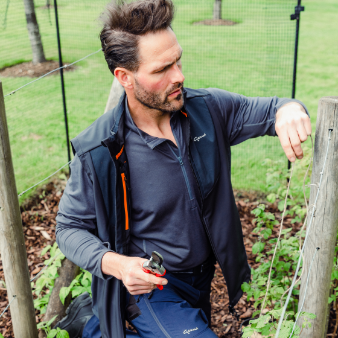Q&A with Helen Barbour, Picton Garden

Tell us about journey into horticulture?
I was virtually born on the potting bench, January baby and the Aster propagation started in February; from then my childhood revolved around the nursery. My playpen was a pile of potting compost and after that, I took to selling plants - at the age of 6 I remember trying to sell Hacquetia epipactis - I was fascinated by green flowers and still am. I’ve always loved plants and after a degree in Botany at the University of Reading, which I loved, I joined the family business. Fourteen years on, I couldn't be happier.
What are the highs and lows of your job?
I am very lucky to share the running of the nursery and garden with my husband Ross, a professional horticulturalist and ex head gardener, with continued propagation help from my Mum, Meriel. It’s great to be able to share the fun bits, like getting ridiculously excited over the first signs of snowdrops, or winning medals for our Asters, as well as the hard parts, such as when a batch of plants fails.
What can you tell us about asters as a genus?
In the UK we mainly only grow the following genii, Aster, Symphyotrichum, Eurybia and Doellingeria. As a group, autumn flowering asters are very diverse, starting to flower from late July right up to late October. Height wise, there are asters ranging from prostrate such as Symphyotrichum ericoides f. prostrata 'Snow Flurry' right up to 2m giants like Symphyotrichum novae-angliae 'Red Cloud'. The colours range from white through the pinks into purples and just touch on the blues but those do usually have a hint of lavender.
What conditions they enjoy in general?
The European asters, Aster amellus, prefer an alkaline soil which has good winter drainage. Most of the others are happy in any good garden soil although the New York asters (Symphyotrichum novi-belgii) don't like getting too dry in summer.
Which aster varieties are good for shade?
While most asters prefer an open sunny position, those in the genus Eurybia will do well in a shade. Eurybia divaricata, E. divaricata 'Eastern Star' and E. schreberi all have white starry flowers and do very well in a shady position particularly if it's not bone dry. Eurybia x hervyi 'Twilight' will also do well in a shady position, standing out from the others with its lavender-blue flowers and upright growth to 90 cm. Symphyotrichum cordifolium, S. lateriflorum and S. laeve will also all tolerate light shade with S. cordifolium 'Chieftain' making a wonderful 'edge of woodland' display with 150 cm plumes of palest lavender-blue in October.
Do you have any personal favourites or recommendations?
Choosing a personal favourite aster is tricky but there are some worth mentioning. For length of flowering, Aster x frikartii is unbeatable whether you choose the best known 'Monch', the more compact 'Wunder von Staffa' or the less well known 'Eiger' and 'Jungfrau'. For wow colour, Sympyotrichum novae-angliae 'Lachsglut' is a brilliant bright cerise-pink New England Aster reaching 130 cm with good upright growth. Symphyotrichum novi-belgii 'Freya' has lovely large semi-double purple-pink flowers from mid-September, meanwhile, the more delicate Symphyotrichum 'Rosy Veil' has a mass of small pale pink flowers. Aster 'Violetta' is a gorgeous dark purple Symphyotrichum novae-angliae (New England Aster) with strong upright growth to 130 cm as is S. na. 'Helen Picton' which is slightly more compact with a better quality flower but still of that wonderful rich purple colouring. You see, it’s hard to choose!
How about mildew?
Asters in general are pretty straight forward but mildew can be a problem particularly with the New York asters (S. novi-belgii). Mixed planting, mulching in spring and regular division can all help to avoid this. But there are many varieties that are mildew resistant or mildew free such as Aster amellus and Aster x frikartii. Some varieties, particularly those with a lot of S. laeve in the breeding can run, but if divided regularly they should be quite manageable. If space is tight choose asters from groups that won't run such as the New England asters (S. novae-angliae), many of the small flowered such as S. cordifolium and S. lateriflorum or of course Aster amellus and Aster x frikartii.
Can you suggest any good planting combinations with asters?
Asters combine well with most other autumn herbaceous as well as grasses. A favourite combination of mine is a purple New England aster such as S. novae-angliae 'St. Michael's' and Rudbeckia subtomentosa. Small flowered asters can look particularly effective when combined with grasses for instance S. 'Little Carlow' and Calamagrostis 'Overdam' or S. 'Coombe Fishacre' backed by Miscanthus 'Dreadlocks'.







